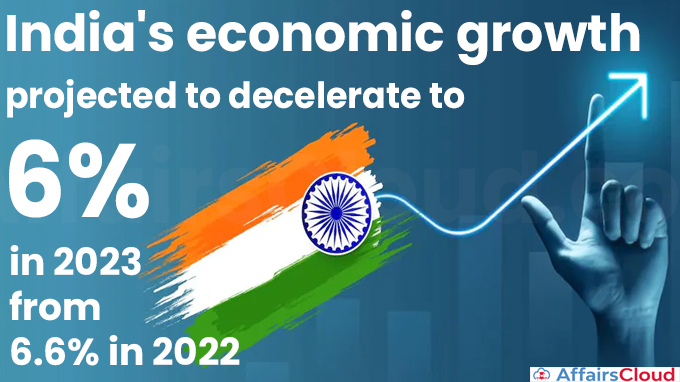 According to the “Trade and Development Report Update: Global Trends and Prospects” (April 2023) report published by the United Nations Conference on Trade and Development (UNCTAD), India’s economic growth is projected to decline to 6% in 2023 from 6.6% in 2022.
According to the “Trade and Development Report Update: Global Trends and Prospects” (April 2023) report published by the United Nations Conference on Trade and Development (UNCTAD), India’s economic growth is projected to decline to 6% in 2023 from 6.6% in 2022.
Note: The International Monetary Fund (IMF) has revised its estimate of India’s economic growth for the current fiscal year (FY24) downward from 6.1% to 5.9%.
Key observations with respect to India:
i.According to the report, India grew at a 6.6% annual rate in 2022, giving up the top spot among G20 (Group of Twenty) countries to oil-rich Saudi Arabia, which grew at an 8.6% annual rate.
- India’s Gross Domestic Product (GDP) growth is anticipated to slow to 6.0% in 2023 as a result of declining government spending and high export orders.
ii.High levels of public and private investment, consumption, and exports had a beneficial impact on India, but greater energy imports have widened the current account deficit (CAD) and depleted reserves.
iii.To lessen the effects of foreign capital outflows, a depreciating currency, and inflation risks, the Reserve Bank of India (RBI) began tightening its policy stance in the spring of 2022.
iv.The Indian government has committed massive infrastructure investment in order to finance its growth objectives, with funding totaling USD 160 billion pledged to both fossil and non-fossil projects in the energy sector alone in 2020 and 2021.
Global Scenario
i.According to the report, global growth will decline to 2.1% in 2023 from 3.1% in 2022.
- It cautioned that as the global economy weakens and financial instability increases, developing nations will face years of turbulence.
ii.South Asia grew at a 5.7% annual rate in 2022, while UNCTAD predicts it to grow at a 5.1% annual rate in 2023, “driven by the growth of its largest economy, India.”
iii.According to the report, highly indebted South Asian nations such as Sri Lanka and Bangladesh would continue to face pressure from external creditors to decrease public spending and cancel social, productive, and climate adaptation projects.
iv.The report states that the growth of the United States (US) would decrease to 0.9% in 2023 from 2.1% growth rate in 2022.
v.China’s growth will increase to 4.8% in 2023, up from 3% in 2022.
Growing Development Crisis in Developing Countries as Debt Levels Rise
i.According to UNCTAD, 81 developing countries’ international reserves decreased by $362 billion (5.3%) in 2022, or $241 billion (7%) if China is excluded.
- It represents an average decrease of 7%, with over 20 countries losing more than 10% of their recent addition of Special Drawing Rights (SDRs).
ii.Furthermore, borrowing costs for 68 emerging markets jumped from 5.3% to 8.5% as measured by sovereign bond yields.
iii.It is anticipated that developing nations would face greater pressure from their foreign creditors to cut their fiscal deficits.
Recent Related News:
In March 2023, The UNCTAD stated in its “Global Trade Update (March 2023)” that, despite deteriorating economic conditions and growing uncertainties, global trade in goods is expected to rise by about 1% (year over year) in the first quarter (Q1) of 2023 while trade in services is projected to grow by about 3% over the same time period.
About the United Nations Conference on Trade and Development (UNCTAD):
Secretary-General – Rebeca Grynspan [first woman & Central American (Costa Rica) to serve as UNCTAD’s Secretary-General]
Establishment – 1964
Headquarters – Geneva, Switzerland
Member Countries – 195 Members




